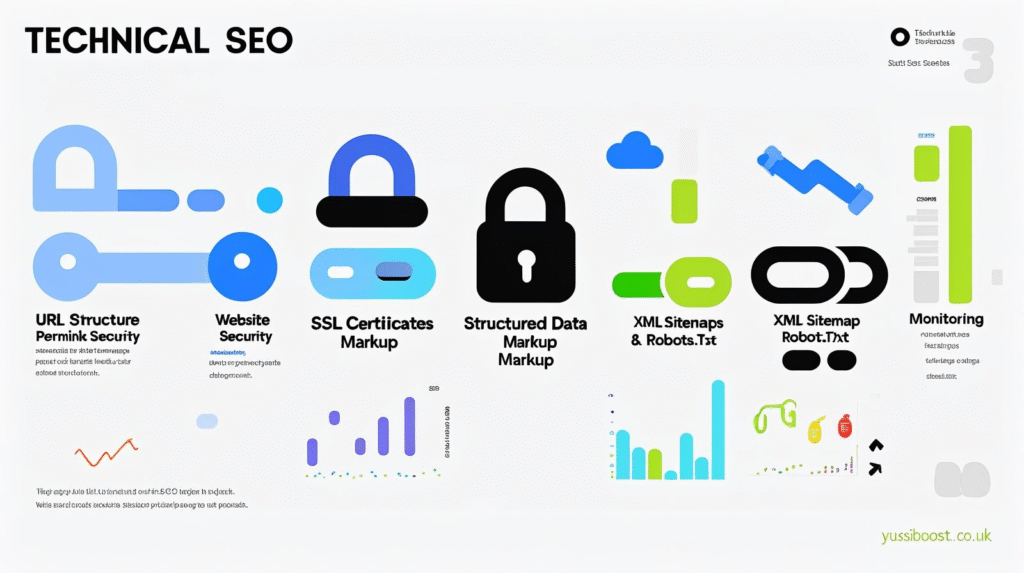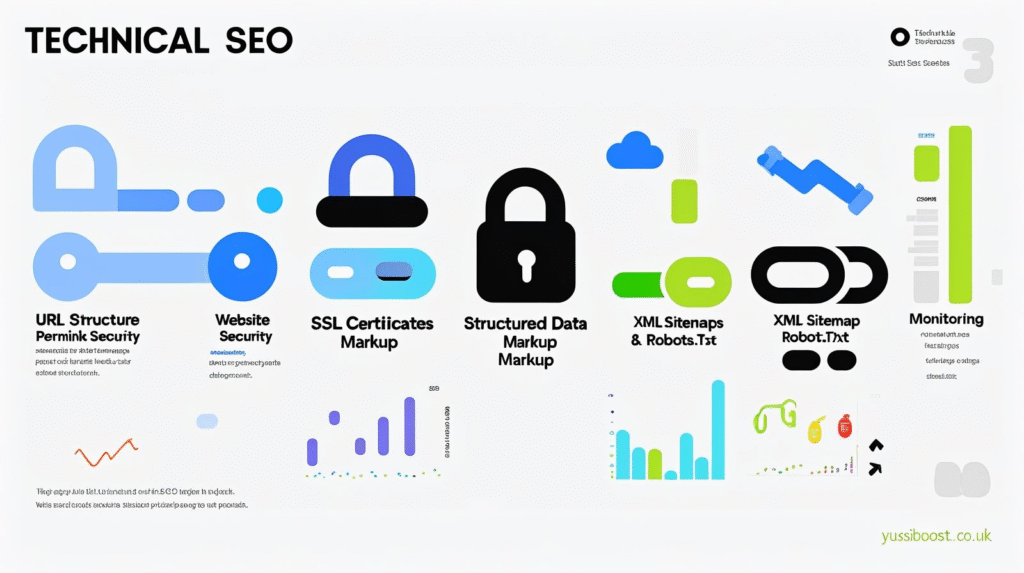Table of Contents


Technical SEO In the ever-evolving digital landscape, where a fleeting moment can capture—or lose—the attention of potential customers, businesses must dig deeper than just creating captivating content and eye-catching designs. It’s here that Technical SEO, often lingering in the shadows of more glamorous marketing strategies, steps into the spotlight. Think of it as the robust engine under the hood of a sleek sports car; it might not be visible at first glance, but its significance is undeniable in driving performance and efficiency. By unleashing the power of Technical SEO, you’re not merely improving visibility but also paving a smoother path for user engagement and satisfaction.
Many businesses overlook the intricacies of Technical SEO, considering it a daunting and overwhelming task reserved for experts. However, mastering these elements can make a significant difference in how search engines perceive and rank your website. Imagine the opportunities lost when your content remains buried beneath competitors simply because of technical oversights. With our comprehensive guide, we’ll unravel the complexities of Technical SEO, equipping you with the tools necessary to navigate this crucial behind-the-scenes area of optimization. Whether you’re a seasoned entrepreneur or a digital novice, understanding these foundational elements will unlock newfound success and drive your business forward in the digital realm.
Importance of Technical SEO in Digital Marketing:
When it comes to digital marketing strategies, understanding the importance of technical SEO is crucial for achieving online success. Technical SEO plays a significant role in optimizing a website for search engines, ensuring better visibility and higher rankings in search results. In the blog post “Unleashing The Power of Technical SEO: A Comprehensive Guide to Website Success,” the focus is on how businesses can leverage technical SEO to enhance their online presence.
Technical SEO involves optimizing a website’s infrastructure, making it easier for search engine crawlers to index and understand the site’s content. By focusing on factors like website speed, mobile-friendliness, and proper URL structures, businesses can improve their search engine rankings and attract more organic traffic.
One key aspect of technical SEO is website speed optimization. Slow-loading websites can deter users and affect search engine rankings negatively. By optimizing images, minimizing code, and leveraging browser caching, businesses can improve their website’s loading speed, providing users with a better experience and boosting their SEO performance.
Another critical factor in technical SEO is mobile-friendliness. With an increasing number of users accessing websites on mobile devices, it is essential for businesses to ensure that their websites are responsive and mobile-friendly. Search engines prioritize mobile-friendly websites, making it a crucial factor for SEO success.
Proper URL structures also play a vital role in technical SEO. Creating SEO-friendly URLs that are descriptive and contain relevant keywords can improve a website’s visibility in search results. By optimizing URLs, businesses can make it easier for both users and search engines to understand the content of their web pages.
In conclusion, technical SEO is a fundamental aspect of digital marketing that can significantly impact a website’s online visibility and success. By focusing on website speed optimization, mobile-friendliness, and proper URL structures, businesses can enhance their SEO performance and attract more organic traffic. Understanding the importance of technical SEO is key to unlocking the full potential of a digital marketing strategy and achieving sustainable online growth.
URL Structure and Permalink Best Practices:

When it comes to URL structure and permalink best practices, incorporating technical SEO strategies is paramount for maximizing website success. By aligning your URLs with SEO best practices, you can enhance your site’s visibility and improve user experience.
1. Keep it Descriptive: Ensure that your URLs are descriptive and indicative of the page content. Including relevant keywords in the URL can boost your page’s visibility for search engines and users searching for similar content. For instance, instead of a generic URL like “domain.com/page123,” opt for a specific and descriptive URL such as “domain.com/technical-seo-url-structure.”
2. Short and Simple: Aim for concise URLs that are easy to read and comprehend. Shorter URLs are not only more user-friendly but also tend to perform better in search engine rankings. Avoid using unnecessary parameters or special characters that could confuse both users and search engines.
3. Hyphens for Separation: When structuring your URLs, use hyphens to separate words instead of underscores or spaces. Search engines recognize hyphens as word separators, making it easier for them to interpret the individual words in your URL. For example, “domain.com/technical-seo-permalink-best-practices” is preferred over “domain.com/technical_seo_permalink_best_practices.”
4. Static URLs: Opt for static URLs over dynamic ones whenever possible. Static URLs, which contain keywords related to the page content, are more SEO-friendly and easier to index by search engines. Dynamic URLs with parameters and session IDs can be complex and may not be as easily understood by search engine crawlers.
5. Canonicalization: Implement canonical tags to address duplicate content issues and consolidate link equity. By specifying the preferred version of a URL, you can avoid diluting your site’s SEO value across multiple variations of the same page.
6. Avoid Keyword Stuffing: While it’s important to include relevant keywords in your URLs, avoid keyword stuffing at all costs. Overloading your URL with keywords can appear spammy and harm your site’s credibility. Focus on creating natural, user-friendly URLs that accurately represent the page content.
By following these URL structure and permalink best practices as part of your technical SEO strategy, you can optimize your website for improved search engine visibility, user experience, and overall success.
SSL Certificates and Website Security:

SSL Certificates and Website Security play a crucial role in ensuring a safe online environment for users. Websites that prioritize security by implementing SSL certificates not only protect their data but also gain trust and credibility among visitors.
When delving into the realm of Technical SEO, it’s essential to address the aspect of website security. Ensuring that your website has a valid SSL certificate is a fundamental step in optimizing for search engines. Search engines like Google prioritize secure websites in their rankings, making SSL certificates a crucial component of your Technical SEO strategy.
By investing in SSL certificates, you are encrypting data exchanged between your website and its visitors. This encryption not only safeguards sensitive information such as login credentials and payment details but also prevents unauthorized access and cyber attacks.
Moreover, SSL certificates also contribute to enhancing user experience. Visitors are more likely to trust and engage with a website that displays the padlock symbol in the address bar, indicating a secure connection. This sense of security leads to increased dwell time, lower bounce rates, and ultimately, improved SEO performance.
In the realm of Technical SEO, website security goes hand in hand with optimizing for search engines. Search engine algorithms favor secure websites, making SSL certificates a non-negotiable aspect of your SEO strategy. By prioritizing SSL certificates and website security, you not only protect your data and users but also boost your website’s visibility and credibility in the digital landscape.
Structured Data Markup for Enhanced Visibility:
Structured Data Markup for Enhanced Visibility
Structured data markup is a powerful tool that can significantly boost a website’s visibility on search engine results pages (SERPs). By incorporating structured data into your website’s code, you provide search engines with valuable information about the content on your site, making it easier for them to understand and index your pages effectively.
When it comes to Technical SEO, implementing structured data markup is a crucial aspect that can’t be overlooked. Search engines like Google rely on structured data to display rich snippets in search results, such as star ratings, product prices, event dates, and more. These rich snippets not only make your listings more attractive to users but also provide them with valuable information at a glance, increasing the likelihood of click-throughs to your website.
There are several types of structured data markup that you can implement on your site, including schema.org markup, which is the most commonly used format. With schema.org markup, you can mark up various elements on your website, such as articles, recipes, events, products, and more, allowing search engines to better understand the context of your content.
By incorporating structured data markup into your website, you not only improve the visibility of your content on SERPs but also enhance the user experience by providing relevant and informative snippets that help users make informed decisions before clicking through to your site.
In conclusion, structured data markup is a powerful tool in the realm of Technical SEO that can have a significant impact on your website’s visibility and performance in search engine rankings. By implementing structured data markup effectively, you can unleash the full potential of your website and drive more traffic and conversions.
XML Sitemaps and Robots.txt Implementation:

XML Sitemaps and Robots.txt Implementation
When diving into the realm of Technical SEO, implementing XML sitemaps and Robots.txt files are crucial steps towards optimizing website performance and visibility. XML sitemaps serve as a roadmap for search engine crawlers, guiding them to important pages on your site, while Robots.txt acts as a gatekeeper, controlling which parts of your site are accessible to search engines.
By including your focus keyword “Technical SEO” in your XML sitemaps and Robots.txt implementation, you are signaling to search engines the relevance and importance of your website in relation to technical optimization. This strategic use of keywords in these files can significantly impact your site’s search engine rankings and overall visibility online.
In your XML sitemap, make sure to include all relevant URLs, including those that are dynamic or hidden within your site’s structure. This comprehensive approach ensures that search engines can easily discover and index all the content on your website, leading to improved organic search traffic and user engagement.
Similarly, optimizing your Robots.txt file with your focus keyword and section keywords helps in fine-tuning which parts of your site are crawled and indexed by search engines. By strategically blocking or allowing access to specific sections of your site, you can ensure that only the most relevant and valuable content is presented to search engine users, improving the overall user experience and driving targeted traffic to your site.
In conclusion, the implementation of XML sitemaps and Robots.txt files plays a vital role in enhancing your website’s technical SEO performance. By incorporating your focus keyword “Technical SEO” in these files and optimizing them to guide search engine crawlers effectively, you are setting the foundation for long-term success and improved visibility in search engine results pages.
Monitoring and Measuring Technical SEO Performance
When it comes to maximizing website success, understanding and implementing technical SEO is crucial. Monitoring and measuring technical SEO performance are key aspects of achieving optimal results.
To unleash the power of technical SEO, constant monitoring is essential. By regularly tracking metrics such as site speed, crawlability, and indexing status, website owners can identify areas for improvement and ensure that their site is optimized for search engines.
Measuring technical SEO performance involves analyzing data to determine the effectiveness of implemented strategies. This includes assessing organic traffic growth, keyword rankings, and backlink quality to gauge the impact of technical optimizations.
Regular audits play a vital role in monitoring technical SEO performance. These audits assess the health of a website by identifying issues such as broken links, duplicate content, and mobile-friendliness, which can affect search engine rankings.
Utilizing tools like Google Search Console, SEMrush, and Ahrefs can provide valuable insights into technical SEO performance. These tools offer detailed reports and analytics to help website owners make informed decisions and continuously improve their SEO efforts.
In conclusion, monitoring and measuring technical SEO performance are essential practices for website success. By staying on top of key metrics, conducting regular audits, and leveraging powerful tools, website owners can optimize their online presence and achieve higher search engine rankings.
Conclusion: Harnessing the Power of Technical SEO for Sustainable Website Success:

To achieve sustainable website success, mastering the art of Technical SEO is paramount. Technical SEO involves optimizing your website’s infrastructure to enhance its visibility and performance on search engines. By focusing on aspects like site speed, mobile-friendliness, and crawlability, you can significantly boost your site’s rankings and attract more organic traffic.
One of the key elements of Technical SEO is optimizing website speed. A fast-loading site not only provides a better user experience but also signals to search engines that your site is reliable and user-friendly. By compressing images, leveraging browser caching, and minimizing redirects, you can improve your site’s speed and overall performance.
Another crucial aspect of Technical SEO is ensuring your website is mobile-friendly. With the increasing use of mobile devices for browsing, having a responsive design that adapts to different screen sizes is essential. Mobile-friendly websites are favored by search engines, leading to higher rankings and better visibility in search results.
Crawlability is also a vital component of Technical SEO. Search engine bots need to easily navigate and index your website to understand its content and relevance to user queries. By creating an XML sitemap, optimizing your site’s structure, and fixing broken links, you can ensure that search engines can crawl and index your site efficiently.
In conclusion, harnessing the power of Technical SEO is crucial for sustainable website success. By optimizing site speed, ensuring mobile-friendliness, and improving crawlability, you can enhance your site’s visibility, attract more organic traffic, and ultimately achieve your online goals. Stay ahead of the competition by prioritizing Technical SEO strategies and watch your website soar to new heights in search engine rankings.
